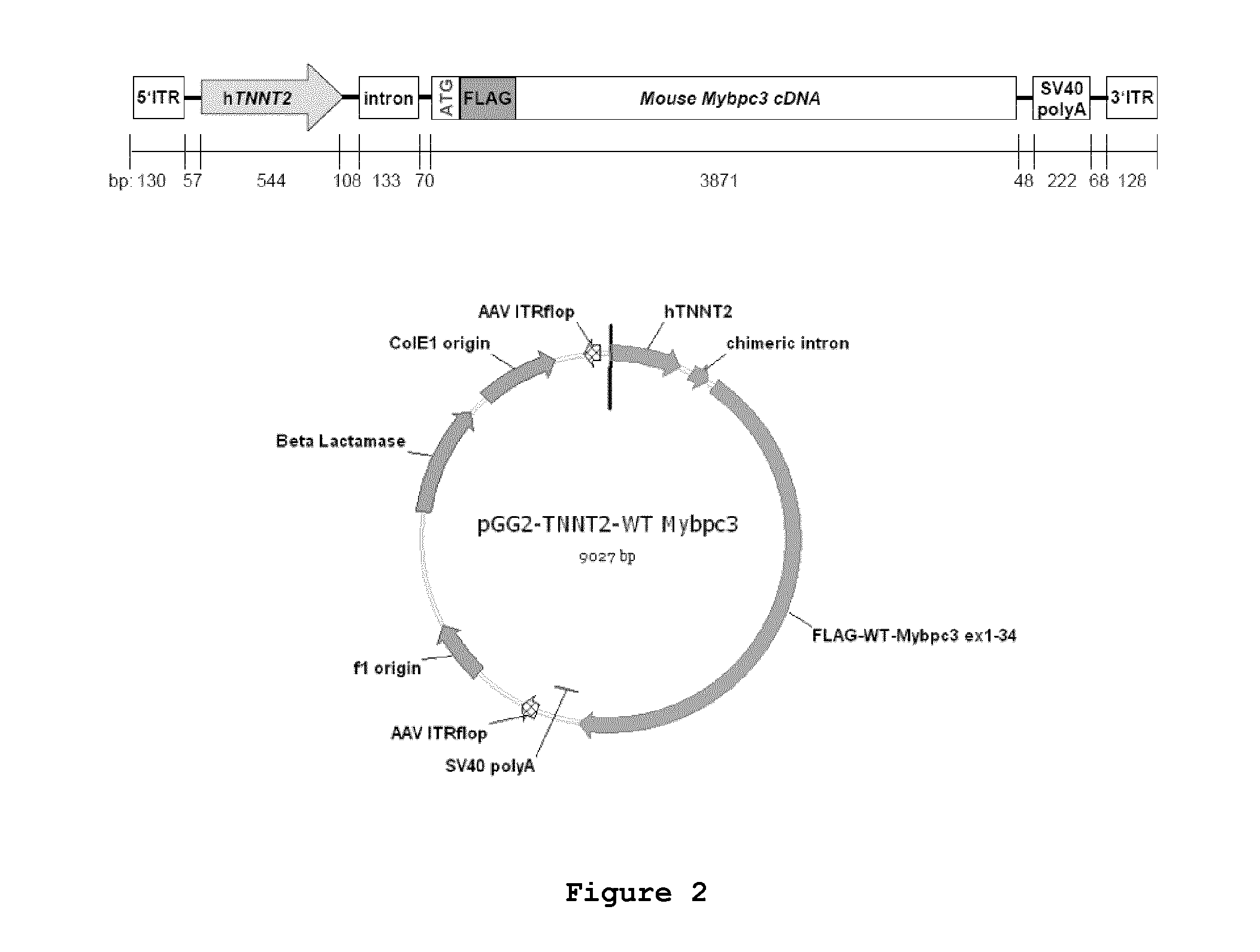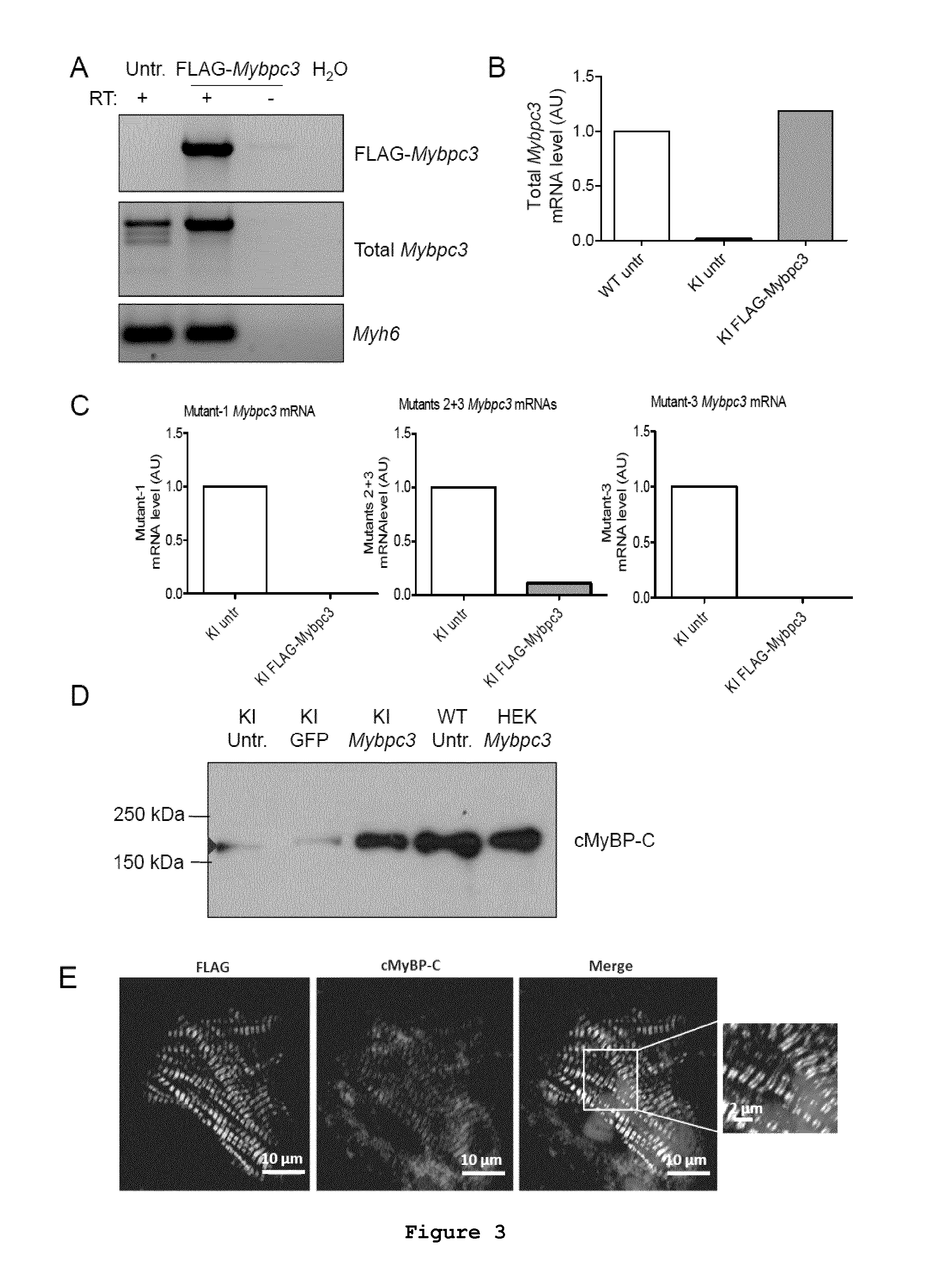Gene-therapy vectors for treating cardiomyopathy
- Summary
- Abstract
- Description
- Claims
- Application Information
AI Technical Summary
Benefits of technology
Problems solved by technology
Method used
Image
Examples
example 1
Consequences of a G>A Transition in Homozygous Mybpc3-Targeted Knock-in Mice
[0079]For both ex vivo and in vivo studies, a knock-in mouse carrying a G>A transition in the Mybpc3 gene (Mybpc3-targeted knock-in; KI) has been developed by gene targeting using the Cre / lox system (Vignier et al., 2009, Circ Res 105:239-248). Briefly, a 8105 bp-fragment containing the 5′ part of mouse Mybpc3 gene, which covers 1747 bp upstream of exon 1 up to exon 15, was obtained by long-range PCR or cloning from a FIX II genomic library derived from a 129 / Svj mouse strain, and then cloned into the pBluescript® II KS+ vector (Stratagene). The G>A transition on the last nucleotide of exon 6 was obtained by site-directed mutagenesis (Stratagene) on a 258 bp PCR fragment, which was then cloned into the Eco47RI / Nsi I sites.
[0080]The phenotype of KI mice appeared normal and they were viable for up to two years (Vignier et al., 2009, Circ Res, 105:239-248). Echocardiography was performed on wild-type (WT) and h...
example 2
Generation of a FLAG-Mybpc3-Containing Vector
[0085]The vector PGG2-hTNNT2-WT-Mybpc3 was constructed by first amplifying the full-length FLAG-tagged mouse Mybpc3 cDNA (GenBank accession number NM_008653.2) including exons 1-34 by RT-PCR from mouse ventricular RNA using the forward primer #3 (5′-TTC GAC CTC GAG ATG GAT TAC AAG GAT GAC GAC GAT AAG CCT GGT GTG ACT GTT CTC AA-3′; SEQ ID NO:11) containing the XhoI restriction site and the FLAG sequence and reverse primer #4 (5′-TTC GAC GGA TCC CTG GTC ACT GAG GAA CTC G-3′; SEQ ID NO:12) containing BamHI restriction site. The human cardiac troponin T (hTNNT2) 5′ region from base −502 to +42 (GenBank accession number NG_007556.1; SEQ ID NO:5) was originally amplified from a human cDNA library by PCR using forward primer #5 (5′-AAA AAA ACG CGT CTC AGT CCA TTA GGA GCC AGT AGC-3′; SEQ ID NO:13) and reverse primer #6 (5′-CCC CCC CAA GCT TCT GCC GAC AGA TCC TGG AGG CG-3′; SEQ ID NO:14) enabling cloning with MluI / HindIII restriction enzymes in a ...
example 3
Evaluation of Mybpc3 mRNA and cMyBP-C Protein Levels and Localisation after Gene Transfer in Cardiac Myocytes Isolated from Mybpc3-Targeted Neonatal KI Mice
[0088]Neonatal mouse cardiac myocytes were isolated from neonatal mouse hearts as previously described (Vignier et al., 2009, Circ Res 105:239-248). Cardiac myocytes were immediately transduced with AAV6-FLAG-Mybpc3 under the control of hTNNT2 at a multiplicity of infection (MOI) of 3000 for 30 min at 37° C. in suspension prior to plating (4.4×105 cells / well). Cardiac myocytes were kept in culture for 7 days at 37° C. and 10% CO2 prior to harvesting.
[0089]HEK293 cells were plated at a density of 2×105 cells in 12-well dishes in DMEM (10% FCS, 1% penicillin-streptomycin) and incubated at 37° C. with 7% CO2 until the recommended confluence of 50-70% was reached. The transient transfection of FLAG-Mybpc3 plasmid into adherent HEK293 cells was performed using the TurboFect transfection reagent (Fermentas) according to the manufacture...
PUM
 Login to View More
Login to View More Abstract
Description
Claims
Application Information
 Login to View More
Login to View More - R&D
- Intellectual Property
- Life Sciences
- Materials
- Tech Scout
- Unparalleled Data Quality
- Higher Quality Content
- 60% Fewer Hallucinations
Browse by: Latest US Patents, China's latest patents, Technical Efficacy Thesaurus, Application Domain, Technology Topic, Popular Technical Reports.
© 2025 PatSnap. All rights reserved.Legal|Privacy policy|Modern Slavery Act Transparency Statement|Sitemap|About US| Contact US: help@patsnap.com



